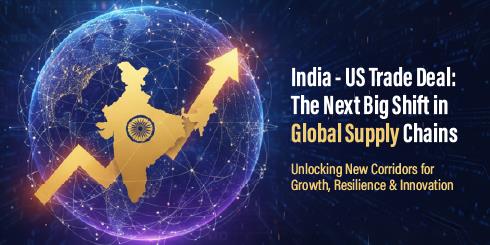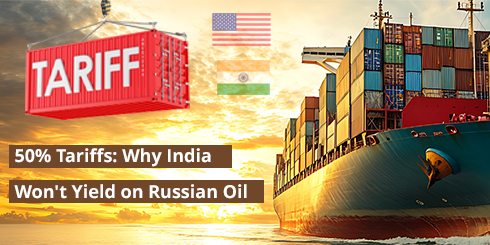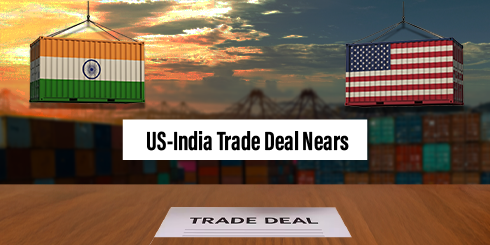What Sergio Gor’s Senate Hearing Reveals About the Future of U.S.–India Relations
In Washington last week, Sergio Gor—the nominee for U.S. Ambassador to India—sat before the Senate for his confirmation hearing. On the surface, it was a routine step in filling a longvacant post in New Delhi. But look closer, and the hearing became something more: a window into how America’s political spectrum now views India. What emerged was bipartisan recognition that India is central to the U.S. strategy in the Indo-Pacific, and a roadmap of issues that will define the next chapter of U.S.–India engagement.
As business leaders and supply chain professionals, we should pay attention. The themes that surfaced—trade, energy, technology, defense, and strategic autonomy—are not abstract policy lines. They directly shape market access, investment opportunities, and global risk management.
1. India at the Core of the Indo-Pacific
Secretary of State Marco Rubio set the tone bluntly: India is “at the core” of America’s IndoPacific strategy. The logic was practical—without a confirmed ambassador who can pick up the phone and get a direct line to the Oval Office, opportunities are missed, and risks multiply. For India, this means Washington wants decisions faster, outcomes clearer, and channels more senior.
For companies navigating bilateral trade, this is encouraging. It suggests less time lost in bureaucratic gears and more emphasis on unblocking stalled negotiations.
2. Trade and Market Access—From Friction to Framework
Trade dominated the conversation. Senators voiced concern about non-tariff barriers, regulatory delays, and restricted access for U.S. exports. Gor countered with “Mission 500”—a goal to double U.S.–India trade to $500 billion by 2030.
How? By targeting quick wins: specific tariff reductions, smoother investment approvals, and pilot projects in sensitive sectors. The tone was not confrontational but calibrated—push firmly, but not so hard that India turns to alternative alignments with Russia or China. For businesses, this signals a structured approach to resolving irritants while keeping the bigger prize in view: a long-term convergence of the two economies..
3. Energy Security and the Russia Equation
India’s imports of Russian crude oil drew sharp questions. Senators explored punitive tariffs on secondary transactions, while Gor emphasized realism: unless the U.S. and allies can supply reliable alternatives at scale, India cannot simply walk away from Russian barrels.
This is a pivotal message. Washington intends to expand LNG and crude exports to India, along with infrastructure support. For India, energy security remains paramount. For U.S. exporters and supply chain players, new opportunities may emerge in energy logistics, storage, and midstream infrastructure.
4. China, the Quad, and Regional Balance
The hearing repeatedly circled back to China. Republicans pressed for a faster, more robust Quad—joint exercises, interoperability, supply chain resilience. Democrats agreed on fundamentals but cautioned against overhyping optics at the expense of substance.
For India, the signal is clear: Washington views defense and deterrence cooperation as steady and resilient, even when trade disagreements flare. For global supply chains, it underscores the Quad’s role not just in security but in setting standards for infrastructure, technology, and resilience.
5. Technology and Supply Chains: Out-Innovating Beijing
On technology, the Senate displayed rare bipartisan unity. The U.S. wants to fuse its innovation ecosystem with India’s scale and engineering depth. The focus: semiconductors, AI, quantum, and secure digital connectivity.
But cooperation comes with conditions: trusted frameworks for IP, export controls, and standards for security and interoperability. For India, this is both an opportunity and a challenge. Done right, it could lock in a “trusted tech corridor” that drives research, pilot production, and manufacturing. For supply chains, it means India is being positioned as a partner of choice in diversifying away from China.
6. Defense: From Big Statements to Everyday Interoperability
The conversation on defense was less about grand deals and more about practical to-do’s: expand joint exercises (especially in high-altitude environments), finalize defense sales, and move toward co-development and co-production. The ambition is clear—normalize everyday military familiarity so that coordination in a crisis is faster and adversary planning is harder.
7. Strategic Autonomy and BRICS
Some senators worried about India’s role in BRICS, especially around de-dollarization. Gor’s response was pragmatic: India often acts as a brake, not an accelerator, on those agendas. Washington respects India’s autonomy but is keen to make partnership with the U.S. the most rewarding option—in finance, technology, and defense production.
This is crucial for business leaders to understand. India will not abandon its independent voice, but it increasingly seeks partnerships that deliver tangible economic and strategic value.
Looking Ahead: What India Should Expect
From the hearing, three parallel tracks stand out:
- Structured trade bargaining: targeted tariff fixes and sectoral pilots that build momentum.
- Energy rebalancing: credible U.S. offers in LNG, crude, and infrastructure to reduce Russian exposure.
- Tech and defense operationalization: concrete progress on joint design, production, and trusted standards in emerging technologies.
And underpinning all this is one method: speed. Washington expects Gor, if confirmed, to operate like a hotline—reducing noise, accelerating compromise, and ensuring India has fast, senior-level access.
Final Thought
The U.S.–India relationship is entering a test phase. Tariffs and Russia remain friction points, but bipartisan consensus in Washington sees India not as an optional partner but as indispensable to the Indo-Pacific. If trade talks gain traction, if energy substitution becomes credible, and if tech and defense cooperation deepen, the relationship could shift from tactical bargains to a strategic bond that reshapes global supply chains.
For companies, investors, and policymakers, this is not just geopolitics. It’s a call to prepare for a future where U.S.–India convergence is one of the defining forces in global trade and security.




